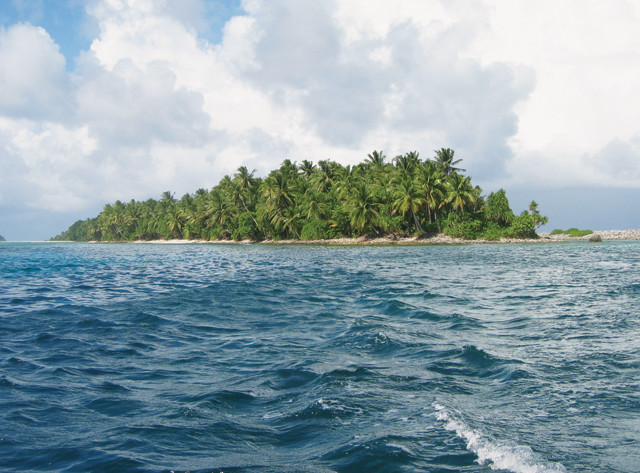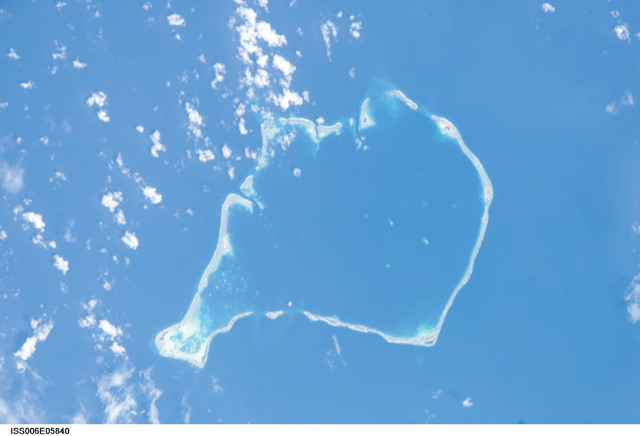
by Timothy Oleson Thursday, August 6, 2015

The island of Funagogo on the eastern side of Funafuti Atoll, Tuvalu. Credit: Paul Kench.
The western Pacific Ocean is home to many atolls: rings of low-lying islands built from calcite sands and the erosional remnants of coral reefs. This region is also home to some of the highest rates of sea-level rise in recent decades — an unsettling fact for the atolls’ inhabitants and others worried that rising waters will eat away at the islands and evict residents for good. But according to a new study documenting long-term change at one Pacific atoll, the future for such islands might not be so bleak.
Intuition says that because atoll islands are low-lying, sea-level rise will essentially drown them and wipe them away, says Paul Kench, a coastal geomorphologist at the University of Auckland in New Zealand and lead author of the new study published in Geology. “You can understand where that [notion] comes from,” he says, but concern for the well-being of atoll nations, such as Kiribati in the Pacific or the Maldives in the Indian Ocean, has arisen mostly out of studies of sea-level rise alone rather than of how atolls are actually responding to it.
To address this knowledge gap, Kench and his colleagues focused on Funafuti Atoll, the capital of the Polynesian nation of Tuvalu, taking advantage of a rare long-term record of the shifting shorelines of Funafuti’s many islands. This record dates back to surveys conducted between 1896 and 1898 during expeditions by the Royal Society of London. Comparing these surveys to aerial photographs taken occasionally beginning in the mid-20th century, and to 21st-century satellite imagery, the researchers cataloged changes in size, shape and position of 29 of Funafuti’s 32 islands over nearly 120 years.
Over the latter half of that period, sea level in the vicinity of Funafuti has risen roughly 5.1 millimeters per year — totaling about 30 centimeters of rise — roughly three times the global average. Yet, Kench and his colleagues found that 18 of the 29 islands studied have actually grown since 1897, with the total land area of the atoll increasing 7.3 percent, or 18.5 hectares; and more than half of the increase has occurred since 1971. Additionally, they reported, Funafuti shorelines have not simply expanded or contracted, but have rotated, lengthened, merged and otherwise changed shape.

Funafuti Atoll, Tuvalu, in the western Pacific Ocean, as seen from the International Space Station in 2002. Credit: NASA Johnson Space Center, Earth Science and Remote Sensing Unit.
Combined with preliminary results from other atolls — in the Marshall Islands, for example — Kench says the picture that emerges is that “these islands are very changeable,” responding mainly to shifts in weather and wave patterns that affect sediment supplies from the surrounding coral reef. In 1962, for example, a major cyclone ripped up a big portion of Funafuti’s reef, depositing a massive rubble ridge on the eastern side of the atoll, which was then gradually distributed to various islands.
Whatever erosion may be occurring from sea-level rise is being masked by shorter-term events, like cyclones, Kench says. Ultimately, as with deltas and other low-lying coastal environments, sediment supply controls if and how coral islands grow or shrink, although it’s a part of the equation that is often ignored in discussions about the future of atoll nations, he says.
These nations have major challenges confronting them related to natural resources and rising seas, but instead of “sending messages to the world that they’re all going to be environmental refugees,” they need to “accept that they’re going to have islands in 50 years and in 100 years, but that those islands are going to be different,” Kench says. “At the moment, most atoll countries have no national database of island area, island elevation, or, indeed, of island change,” he says. “If you have that information, you can then make sensible decisions about where you put people and where you put infrastructure” in the future.
Showing what has happened historically in a place like Funafuti is “useful and powerful, rather than talking about theory,” says Robert Nicholls, a coastal engineer at the University of Southampton in England who was not involved in the new study. This work “calls out for a larger geographic study … to see if this [phenomenon] is typical.”
But, Nicholls says, the key question in all of this is not just whether an island, or islands, will survive into the future, but “does a habitable island survive?” Even if some atoll islands grow and change shape, rising seas and waves will still increase the flood risk for inhabited, urbanized islands, he says. And while “older islander societies … that moved around [from island to island] were in tune” with atolls’ shape-shifting nature, he says, “modern society finds it pretty hard to deal with, I think.”
© 2008-2021. All rights reserved. Any copying, redistribution or retransmission of any of the contents of this service without the expressed written permission of the American Geosciences Institute is expressly prohibited. Click here for all copyright requests.